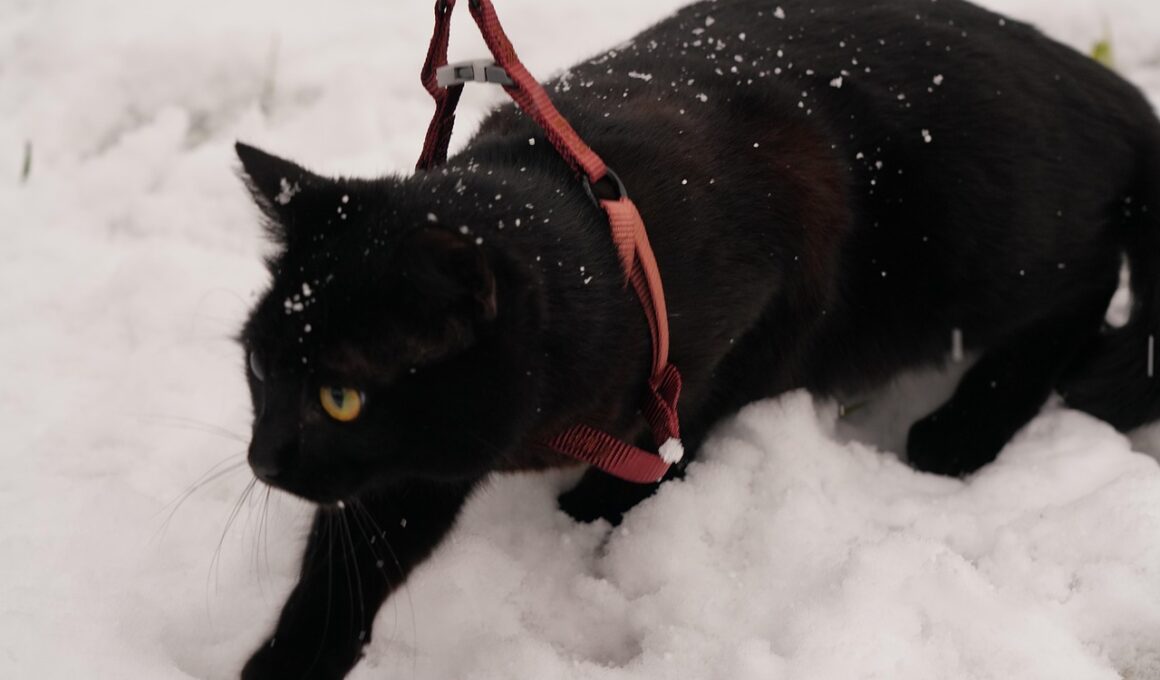Signs Your Cat is Ready for Leash Walking Outdoors
Introducing your cat to leash walking can be an exciting venture for both of you. However, it’s imperative to ensure your feline friend is ready for outdoor exploration. The first sign to look out for is curiosity. If your cat frequently gazes out of windows or follows movement with intent, they may be eager to engage with the great outdoors. Observe their behavior; they should have an interest in what’s beyond the walls of your home. Most cats display heightened curiosity when they are in a stress-free atmosphere. Engaging toys can also help stimulate their senses before attempting leash training. Another crucial indication is when your cat is comfortable wearing a harness. If your cat willingly accepts a harness and doesn’t exhibit signs of distress, this is a positive step forward. To further enhance their adaptability, introduce them slowly to the harness first at home, ensuring it fits snugly without causing discomfort. Furthermore, consider your cat’s age and overall health; younger and active cats often adapt quickest to leash walks, while older cats may take longer to feel comfortable with new experiences.
The next important sign your cat may be ready for leash walking is their playful energy. Cats who show excitement when you get their leash and harness ready are typically more willing to explore outside with you. This eagerness can manifest as playful behavior, such as jumping around or meowing animatedly when they see the gear. Additionally, observe if your cat exhibits a calm demeanor in new environments. A cat that doesn’t get easily overwhelmed by novel surroundings is likely to adjust better to walking on a leash. Introduce your cat to various sounds and smells slowly within your home or backyard. This acclimatization process can help ensure they are prepared for outdoor adventures. Gradually increase their exposure to different stimuli without overwhelming them. Another pointer is to monitor your cat’s reaction to being outdoors. If they show interest and actively want to venture outside by approaching the door or window, they surely could be ready. Finally, let your cat take the lead during early walks by allowing them to dictate the pace and direction. This encourages confidence and enjoyment during your outdoor explorations together.
Benefits of Leash Training for Cats
Leash training is not just about getting your cat accustomed to wearing a leash; it can enrich their life considerably. Outdoor exploration under controlled conditions can be immensely beneficial for your cat’s mental and physical health. Cats naturally possess a curious nature, fueled by instincts to explore. By walking them on a leash, you satisfy this urge while keeping them safe from dangers such as cars or aggressive animals. Moreover, it provides an excellent opportunity to expose your cat to various environments. This could include the sights and sounds of a busy street, the tranquility of a park, or the natural wonders of a hiking trail. Regular outdoor activities can help combat obesity, as many cats struggle with maintaining a healthy weight indoors. Introducing workouts through playing with toys during walks can increase your cat’s activity level substantially. Furthermore, leash training can strengthen the bond between you and your cat. Shared experiences outdoors help create cherished memories and allow both of you to exercise together, stimulating both physical activity and emotional connections. Hence, leash walking is a multifaceted experience, yielding improvement in numerous aspects of your cat’s life.
Another critical sign of readiness for leash walking is your cat’s willingness to follow you around within your home. If your cat shows that they enjoy being near you and often seeks your company, they are likely to feel secure when exploring outside. Positive reinforcement during your indoor interactions can also foster a sense of trust. Encourage your cat to walk alongside you without feeling pressured. Use treats or enticing toys to reward them when they follow, as this builds a habit of companionship. It’s essential to ensure that the collar or harness fits correctly; a secure fit without being too tight enhances their comfort level. Never rush the training process; allow your cat to adjust at their own pace. Each cat has their unique personality, taking different lengths of time to acclimatize to new experiences. Pay attention to their body language, including signs of relaxation or tension. When cats begin to explore their surroundings curiously, it’s a strong indicator they are ready to take the next step into leash training. Stay patient and continue to observe their reactions to ensure a joyful walking experience.
Understanding Your Cat’s Body Language
Understanding a cat’s body language is crucial in determining their comfort level with leash walking. If your cat shows behaviors such as purring, rubbing against you, or kneading with their paws, they are content and comfortable. Recognizing these signs while adjusting a harness is essential. Additionally, fluffed tails often indicate nervousness, and understanding this regarding their readiness can prevent uncomfortable experiences. If your cat attempts to escape the harness or constantly tries to scratch it off, this suggests aversion to the new sensation. In contrast, a relaxed posture, such as lying on their side or rolling over, indicates comfort with the new gear. When a cat approaches the front door, sniffing and playing nearby, it often indicates a readiness to go outside. Conversely, if your cat hides or displays a defensive posture, it’s best to postpone leash training until they feel more secure. Establishing regular routines and observing your cat’s reactions can help solidify prior education. Moreover, consider the presence of distractions in your surroundings before venturing outdoors. Minimizing loud noises and sudden movements can contribute to a more enjoyable experience during leash walking.
Another essential factor in determining your cat’s readiness for outdoor leash walking is their overall health status. If your cat is currently undergoing medical treatments, it may result in increased anxiety or discomfort in new situations. Make sure to consult your veterinarian before undertaking leash training, especially for older cats or those with health conditions. Their advice can guide on whether it’s appropriate for your cat to engage in outdoor walks. A healthy cat tends to exhibit playful behavior and displays interest in their surroundings, signifying engagement and curiosity. Proper vaccinations and preventive treatments should also be considered before exposing your cat to other animals in public areas. Outdoor environments can harbor risks that indoor living does not, so ensuring your cat is healthy will minimize unnecessary risks. Additionally, monitor the weather; high humidity or extreme temperatures can be detrimental to your cat’s health during walks. An appropriate leash equipped with proper fittings can also contribute to a pleasant experience. Ensuring smooth and secure walks allows both you and your feline friend to relish the time spent together outdoors without distress or discomfort for either party.
Gradual Outdoor Introductions
Once you’ve assessed your cat’s readiness for leash walking, it’s vital to introduce them gradually to the outdoor environment. Start with short sessions in a quiet backyard or a secure area, allowing your cat to explore cautiously. Your presence should offer reassurance as they adjust to the new sounds and movements. Begin by letting your cat sniff and roam around at their pace; this fosters confidence and eases anxiety during exploration. A calm approach will help set the tone for future outings. Gradually increase the length of these sessions, aiming for positive experiences in a controlled manner. Monitor your cat’s behavior throughout, and if they show signs of discomfort or fear, take a step back. Revisit indoor acclimatization and engage them positively to build their confidence before returning to the outdoors. This gradual introduction process is especially crucial for sensitive cats; rushing your cat can lead to negative associations with the leash. Afterward, venture out to more stimulating environments like parks and trails, ensuring each outing remains enjoyable while still within a safe and controlled setting.
Throughout your leash training journey, persistence and patience are your best allies. Cats often take time to adapt to anything new, and leash walking is no exception. Each cat is unique in personality, and some will embrace leash walking quickly, while others may take over weeks or even months. Reward your cat’s accomplishments, no matter how small, with their favorite treat or toy. This promotes positive reinforcement and cultivates a fun learning experience. Create a familiar routine around leash walking to give your cat a sense of security; this breeds confidence and enthusiasm during each session. Prepare their favorite treats in advance to keep them motivated throughout the training phases. Remember to maintain a gentle and calm demeanor at all times, as your attitude significantly influences your cat’s behavior. If your cat appears anxious, it is advisable to halt the session and resume later when they seem more appropriate. As your cat grows more accustomed to the leash, consider exposing them to new experiences gradually; perhaps adding different sights and sounds to enhance their outdoor adventures. Ultimately, a happy and sociable cat is the goal, and a little patience will lead to enjoyable walks for both of you!


